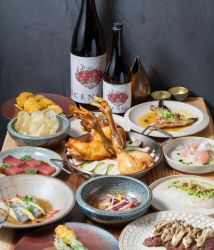
March 16, 2025
Spring in Japan 2025: Seasonal Foods and Traditions
Japan's food and drink agenda
Halfway between winter and the spring equinox, plum blossoms begin to bloom across Japan, marking the start of the much-anticipated spring season. The 88th day of spring signals the beginning of the tea-picking season, with fresh leaves from this early harvest fetching high prices. Meanwhile, 210 and 220 days from the start of spring are considered high-risk days for typhoons, which often cause concern among farmers. Since ancient times, Japan has taken seasonal cues from nature, and this is particularly reflected in its cuisine. If you’re in Japan during spring, expect a unique selection of seasonal delicacies and drinks.

Sansai
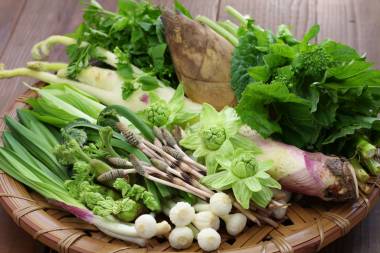
These are the wild mountain vegetables that poke their welcome heads out as soon as the snowy blankets and chill of winter start to give. Sansai are usually bitter and provide timely astringence to break down fat and toxins stockpiled through colder months. The most common types include takenoko (bamboo sprouts), taranome (Japanese angelica tree roots), fuki (butterbur), and nanohana (rapeseed).
You might also enjoy reading Japan’s Lost Tradition of Wild Food: ‘Eating Wild Japan’ tracks the culture of foraged foods with a guide to plants and recipes.
Hanamizake (cherry blossom viewing sake)
Since the Heian period, spring’s blossoming sakura trees have been causing celebratory picnics, drinking, dancing, and general frivolity. Hanamizake is sake served with sakura petals added to it, making a fittingly darling drink for blossom appreciation festivities.
Seasonal booze releases
In other parts of the world, glasses of sweet Pimms, crisp cider, and chilled rosé are guzzled in spring-has-sprung glee. In Japan, special-release spring beverages bring this seasonal titillation through floral, pink, and vine-draped packaging and in-theme flavor profiles. Special spring-release sakes are aromatic, bright, and elegant. Many come with tinged pink from ingredients such as red shiso, red rice koji, ancient purple rice, or flower petals combined with the brewing mash. Spring beer varieties are fragrant and slightly bitter and may also be colored and flavored with flowers and seasonal fruit like cherries, strawberries, and plums.
Shinshu (“new sake”)
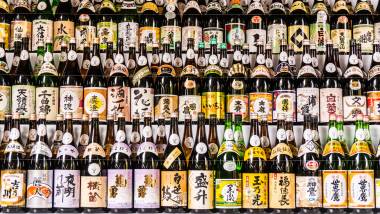
Traditionally, the sake brewing season takes place between late autumn and spring, following the summer rice harvest. The first batches are pressed around December and set aside to age. This process rounds and mellows out flavors and can take 6 to 18 months to complete. Shinshu, however, is sake that is pressed and sent straight to market without any maturation. These brews bring mouthfuls of spring vitality with their characteristic youthful liveliness and fresh, zingy taste.
Seafood
Although in abundance all year, the varieties of seafood to look out for in spring include sayori (halfbeak), sawara (Spanish mackerel) and nishin (sardine). There’s also mebaru (rockfish), madai (red sea bream), hatsu-gatsuo (spring bonito) and shirasu (baby sardines). Shellfish is also popular, including sazae (turban shell), various clams like aoyagai (surf clam), akagai (red clams) and asari (littleneck clams). Then there’s ise ebi, kuruma ebi, hotaru ika (firefly squid), hamo (conger eel) and kazunoko (herring roe).
Fresh seaweed
Along with blossoming sakura and sprouting wild vegetables, the ocean’s garden comes into bloom during spring. March and April are the time to sample fresh seaweed varieties like wakame, hijiki, mekabu and mozuku. This is when the waters are warm, and the sea vegetables flourish before withering in summer. Try these nutritional powerhouses in soups, salads and tempura.
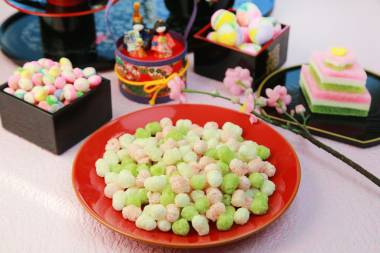
Spring ceremonial fare
Girl’s Day on March 3 has already passed this year, but it remains one of the most important spring festivals in Japan. Families celebrated by displaying ornamental dolls and eating colorful rice cakes and sweets. These include hishimochi (pink, white, and green layered rice cakes), arare (sweet puffed rice), and amazake (a sweet, low-alcohol rice drink). For shunbun no hi, botamochi, people eat sweets of chunky, sticky rice wrapped in red bean paste. Celebratory food for Children’s Day on May 5, 2025 includes chimaki, sweet or savory steamed sticky rice cakes. These are wrapped in bamboo leaves. Kashiwamochi, mochi filled with red bean or white bean and miso paste come in an oak leaf.
Sparkling sake
An increased amount of “shuwa shuwa” (effervescent) sake also hits the market in spring. The refreshing fine bubbles, sweet and sour taste, and lower alcohol levels of the drink make it a popular option for sipping away balmy afternoons.
Sakura mochi (cherry blossom dumplings), kusa mochi (grass dumplings), ichigo daifuku (strawberry dumplings), usugi mochi (warbler dumplings) are popular during spring in Japan
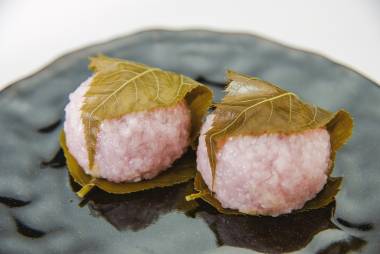
These are some signature springtime wagashi, a traditional and highly decorative type of Japanese sweet. It draws heavily from the seasons for inspiration. Sakura mochi are small balls of pink-tinged rice filled with red bean paste and wrapped in a pickled sakura leaf. Kusa mochi are soft, sweet rice cakes with mugwort, a seasonal herb, kneaded into the dough. Ichigo daifuku are rice cakes filled with bean paste and fresh strawberries that are seasonal. Usugi mochi is small mounds of bean paste wrapped with a very soft, sticky type of mochi. It’s dusted with green soybean flour to evoke an image of a bird hiding in greenery.




